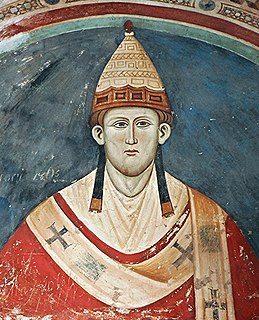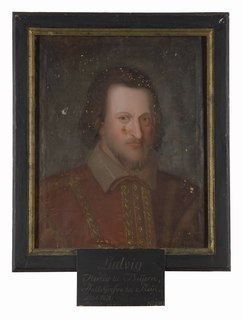
Pope Innocent III, born Lotario dei Conti di Segni, was the head of the Catholic Church and ruler of the Papal States from 8 January 1198 to his death in 16 July 1216.
Philip of Swabia was a member of the House of Hohenstaufen and King of Germany from 1198 until his assassination.
Adolf of Altena, Adolf of Berg or Adolf of Cologne, was Archbishop of Cologne from 1193 to 1205.

Louis I, called the Kelheimer or of Kelheim, since he was born and died at Kelheim, was the Duke of Bavaria from 1183 and Count Palatine of the Rhine from 1214. He was a son of Otto I and his wife Agnes of Loon. Louis was married to Ludmilla, a daughter of Duke Frederick of Bohemia.

The Diocese of Halberstadt was a Roman Catholic diocese from 804 until 1648. From 1180, the bishops or administrators of Halberstadt ruled a state within the Holy Roman Empire, the prince-bishopric of Halberstadt. The diocesan seat and secular capital was Halberstadt in present-day Saxony-Anhalt.

Henry V, the Elder of Brunswick, a member of the House of Welf, was Count Palatine of the Rhine from 1195 until 1212.
Otto I was Count of Burgundy from 1190 to his death and briefly Count of Luxembourg from 1196 to 1197. He was the fourth son of Frederick I, Holy Roman Emperor, by his second wife Beatrice I, Countess of Burgundy, daughter of Count Renaud III.
Conrad of Wittelsbach was the Archbishop of Mainz and Archchancellor of Germany from 20 June 1161 to 1165 and again from 1183 to his death. He was also a cardinal of the Roman Catholic Church.
Otto I of Guelders (1150–1207) was a Count of Guelders and Zutphen from 1182 until his death in 1207. He was a son of Duke Hendrik of Guelders and Agnes of Arnstein. He married Richardis of Bavaria in 1184. Richardis was a daughter of Otto I Wittelsbach, Duke of Bavaria.

Peter of Capua was an Italian scholastic theologian and prelate. He served as cardinal-deacon of Santa Maria in Via Lata from 1193 until 1201 and cardinal-priest of San Marcello al Corso from 1201 until his death. He often worked as a papal legate. He wrote several theological works and was a patron of his hometown of Amalfi.

The Crusade of 1197, also known as the Crusade of Henry VI or the German Crusade, was a crusade launched by the Hohenstaufen emperor Henry VI in response to the aborted attempt of his father, Emperor Frederick I, during the Third Crusade in 1189–90. Thus the military campaign is also known as the "Emperor's Crusade".
Ottaviano di Poli, a member of the family of the Counts of Poli, was an Italian Roman Catholic Cardinal.

Henry VI, a member of the Hohenstaufen dynasty, was King of Germany from 1169 and Holy Roman Emperor from 1191 until his death. From 1194 he was also King of Sicily.

Conrad of Querfurt was a prince of the church in the Kingdom of Germany. He was the bishop of Hildesheim (1194–1199) and the bishop of Würzburg (1198–1202), served two kings as chancellor (1194–1201) and went on the Crusade of 1197.

Pietro Diani was an Italian cardinal. The name "Diana" is incorrect; he signs himself Petrus Dianus.

Peter was an Italian Cistercian monk and prelate. He was the abbot of Rivalta from 1180 until 1185, abbot of Lucedio from 1185 until 1205, abbot of La Ferté from 1205 until 1206, bishop of Ivrea from 1206 until 1208 and patriarch of Antioch from 1209 until his death. He is known as Peter of Magnano, Peter of Lucedio or Peter of Ivrea.
Conrad of Krosigk was a German prelate, crusader and monk. He served as the bishop of Halberstadt from 1201 until 1208 and took part in the Fourth Crusade in 1202–1204. He resigned his see to become a Cistercian monk at Sittichenbach Abbey. In his retirement, he undertook frequent Papal missions.
The Deeds of the Bishops of Halberstadt is an anonymous Latin chronicle of the diocese of Halberstadt from its foundation in 780 down to 1209.
Gerardo da Sesso was an Italian monk, bishop and cardinal of the Catholic Church.